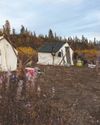Activists are determined to halt the construction of a new migrant detention centre in Laval

It was a cold New Year’s Eve in Laval, the island suburb just north of Montreal. A few hours before 2018 turned to 2019, a group of about 150 people had bused into Laval. Bundled against the cold, with backpacks full of fireworks and noisemakers, they were getting ready to ring in the new year with a demonstration.
Sandwiched between Laval’s industrial section to the east, farmland to the north, and sprawling suburbs to the west, there is an area of the city with four prisons, all next to one another. A minimum security “federal training centre”; the Leclerc provincial women’s prison; a multi-level security federal training centre; and a detention centre for migrants, administered by the Canada Border Services Agency (CBSA).
Every year, anarchists and prison abolitionists organize noise demonstrations outside the four facilities on New Year’s Eve. It’s part of an international anarchist tradition, whose origins are unclear, and serves as a way to remind the people inside that they aren’t alone at a particularly difficult time of year. Participants shoot fireworks into the air, bang drums, and rattle the fences that surround buildings filled with cages.
“Every city, every town, burn the prisons to the ground.” Four prisons, four stops planned in the demonstration. But this year, an extra stop was added to the itinerary – the site where CBSA plans to build a new detention centre for migrants.
Stopping at a nondescript spot, a patch of open land between the existing jails, speakers told the crowd about the CBSA’s plans for the new detention centre, garnering boos from listeners. One speaker described having family members who had been locked inside the existing migrant facility nearby, and affirmed that no new prison would be built.
Esta historia es de la edición July/August 2019 de Briarpatch.
Comience su prueba gratuita de Magzter GOLD de 7 días para acceder a miles de historias premium seleccionadas y a más de 9,000 revistas y periódicos.
Ya eres suscriptor ? Conectar
Esta historia es de la edición July/August 2019 de Briarpatch.
Comience su prueba gratuita de Magzter GOLD de 7 días para acceder a miles de historias premium seleccionadas y a más de 9,000 revistas y periódicos.
Ya eres suscriptor? Conectar

PLATFORMS FOR PEOPLE, NOT PROFIT
Digital platforms boast that they’ve “democratized” cultural production. But what would truly democratic platforms look like in Canada?

ORGANIZING THROUGH LOSS IN THE HEART OF OIL COUNTRY
The story of climate justice organizing in Alberta, at the heart of the tarsands, is the story of a group of young activists learning what it means to lose, and keep on fighting

GROWING THE LABOUR MOVEMENT
How unions are using community gardens to engage members, nourish communities, and help strikers weather the picket line

A NEW ERA FOR OLD CROW
In the Yukon’s northernmost community, the Vuntut Gwitchin First Nation is reckoning with how to preserve their land and culture, amid a warming climate and an influx of tourists

“At Least Hookers Get Wages”
The risky business of sex work in the gig economy

The Literal – And Literary – Futures We Build
Briarpatch editor Saima Desai talks to two judges of our Writing in the Margins contest about Idle No More and MMIWG, ethical kinship, writing queer sex, and their forthcoming work.

The Cost Of A T-Shirt
In Honduras, women maquila workers are fighting back against the multinational garment companies that they say are endangering their health and safety.

Milking Prison Labour
Canada’s prison farms are being reopened. But when prisoners will be paid pennies a day, and the fruits of their labour will likely be exported for profit, there’s little to celebrate.

Bringing Back The Beat
In mainstream media, labour journalism has been replaced by financial reporting and business sections. But journalism students are raising the labour beat from the grave.

There's No Journalism On A Dead Planet
Corporate media owners are killing local newspapers – which is making it impossible for everyday people to understand the on-the-ground impacts of the climate crisis